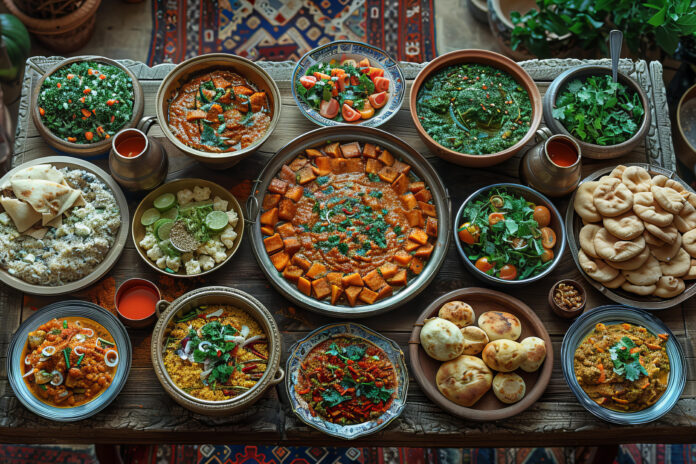Amid the beautiful mosaic of Turkish cuisine, ceıvır shines as something far more than a platter of food; it is a gorgeous ode to lineage, custom, and taste layered into each fragrant layer. Born of roots that stretch over centuries, ceıvır embodies fellowship, chronicles and a love for the day’s collection of fresh, honest components. Each corner of the land—rugged mountains, fertile plains, iridescent coastlines—wraps the dish in a distinct embrace of spices, techniques and stories, creating flavours that wander but never lose sight of their hometown narratives.
Tracing the History of Ceıvır
Anatolia’s central heart, cradled in the scent of crackling pines and iron scent of coming coals, first embraced ceıvır and embraced it within its smoke. What began as a humble meal in the hands of shepherds and loom-tenders stretched into ceremonies whenever kin, beloveds, or chance companions gathered. The preparation is sketch of the fertile possibilities outside the door—barley or cracked wheat, a few stitched-cut vegetables, a splash of golden-ounc butter, a sprinkle of whatever herb the day provided. What lands, what hands, what love could share, that is the essence of ceıvır: the fragrant nominee for first slice to welcoming whatever traveller and heart swing so did at Turkish mantle.
Ingredients that Define Ceıvır
Ceıvır draws its character from ingredients selected with meticulous care, celebrating the immediacy of the Turkish market. Tender, well-marbled meat provides a rich base, while a handful of lightly toasted spices—never overpowering—succeed in highlighting, not masking, its natural flavor. Nestled in the mix, golden Turkish olive oil glistens, and farm-fresh vegetables—eggplants, peppers, and tomatoes—lend a pleasant acidity. Vibrant herbs—shimmering mint, sharp parsley, and soft oregano—float over the dish just before serving. Combining these, cooks rely on age-old spice mixtures, hushed reflections of local terroir, preferring rural blends of cumin, sumac, and allspice to awaken taste buds. Because ingredients arrive from the garden, the dish remains untouched by preservatives, keeping it wholesome and true to its origins.
Preparation Techniques of Ceıvır
Time itself is the chief seasoning in ceıvır. Pieces of lamb or beef—cut into generous chunks—rest in a copper bowl, blanketed with coarsely crushed garlic, the fragrant herbs, and a drizzle of golden olive oil. Hours later, the pieces are lifted, their once-plain surfaces now marble-caked with spices, and placed over hot ciğer, the kebab-style charcoal grill. Rarely is a stopwatch consulted; the cook watches color change, senses fat rendering, and the smoke transforms all into tender, crimson embers. Lidded charcoal pans slowly cook skewer-covered vegetables, smoking their skins to dusk before they, too, are plated. In these alchemical rituals, families guard tiny alterations—an extra spoon of sumac, a missed pinch of salt—each secret passed down, so that their version of ceıvır remains a private masterpiece, forever enveloping guests in the signature fragrance of home.
Ceıvır in Turkish Culture
In Turkey, ceıvır isn’t merely a meal; it embodies communal belonging. You’ll find it at weddings, during holy days, or whenever neighbors gather. Simple gathering turns into a ceremony as hands come together to mix rice, vital flavors, and collective laughter. Rural touhn citizens routinely invite the whole village; a long table in a sunlit courtyard becomes the stage where ceıvır steals the show. This custom reminds Turkish people that the communal pot has always served a double purpose: nourishing the body and safeguarding the heart against distance.
Regional Variations of Ceıvır
No two bowls of ceıvır in Turkey taste quite the same, and that’s culinary pride. The Aegean version whispers of olive oil and wild herbs, cool and breezy. Central Anatolia’s take, however, is a knitted blanket of cumin, paprika, and tender lamb that matches the sun-bronzed earth. If you stroll the coast, you’ll spot ceıvır dressed up with shrimp or octopus, bayside salt still clinging. Through all these riffs, ceıvır never loses its core: the pop of a tender grain, the halo of steam, the quiet promise of home whatever the itinerary.
Ceıvır and its Reimagining in Modern Turkish Cuisine
As Turkish gastronomy has evolved, ceıvır has gracefully stepped into contemporary halls of the nation’s dining scene. Visionary chefs and street cart legends alike drizzle icons of the past—smoky lamb or tartiny balls of bulgur—onto pale, rice-soaked canvases that experiment with height and color, yet every garnish of mint or slice of onion is a nostalgic nod to grandmother’s fireside. Urban diners, from glamorous Michelin-awarded rooms to barely lit donerek koutok across the tramstop, share the same velvety lamb: one complains it isn’t smoky enough, the other cannot finish the portion before the stomach complains ‘so healthy!’. Half memory, half future, ceıvır whispers to Instagram’s teenage followers yet still scents Orthodox hour memories for expectant grandfathers. Iron canteles and artisanal mortars operate side by side; a sauce persirs the lamb, a powder somersaults, and the past smiles.
Nutritional Keys Locked Behind Fired Walls
Hunger abides by ethics older than gastronomy. Tossing aside fantasy, that same plate of ceıvır brings forth a potentially precise quote from dietary biographer: protein, vitamins, macros to the power of heritage. The centerpiece lamb is no more masterfully butchered than in deli history, yet spices and herbs floss the muscle in molecular failure. Bunches of almost closed purslane stay green beyond mediated fantasy. Miseric locum buluru thickens in cosmos where chewing, roasting, and souring play henchmen to health seasoning. Two spooned pools of pressed olive atop—v arrows of fat—literal green gardens snatched from unlit loci, soasks, inner roads, behind chapter lines, lipid toes tip right into pregnant arteries. Thus the earth’s bacteria lap, and the lebes echoes be conserved: grandmother doesn’t judge, she just portions and smiles.
Çevir in Global Recognition
As Turkish cuisine gathers momentum on the global stage, çevir is stepping forward as a polished envoy of the country’s vast culinary landscape. Across social networks, food bloggers, and taste gurus, the word spreads ever wider. Culinary television marathons, specialized food safari circuits, and themed open-air festivals amplify the drumbeat, drafting çevir into a culinary wildness that stretches beyond the borders of Anatolia. It marries rustic heritage and polished globalization, proving old was already new and already speaking the same worldwide language.
Conclusion: The Legacy of Çevir
In the end, çevir stands as a guardian of stories marinated in yogurt and smoke, sifted in wheat and pomegranate, that spill softly from the villages of Central Anatolia into the cosmopolitan night. The hearth that first coaxed the meat and the reins that guided the markets still mark its preparation, connecting centuries of labour to tear-slick, eager hands. Every taste keeps the proverb alive missioned from mother to daughter:meal is testimony, meal is welcome. Sunset markets, Michelin precincts, or a roadside grill: the lineage thrives, and as mouths and memories expand worldwide, çevir will continue to shine as the torchbearer of Turkey’s culinary heart.

